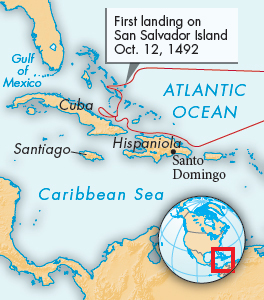Spain’s Voyages to the Americas
Christopher Columbus, a native of Genoa, was an experienced seaman and navigator. He had worked as a mapmaker in Lisbon and had spent time on Madeira. He was familiar with such fifteenth-
Columbus was also a deeply religious man. He had witnessed the Spanish conquest of Granada and shared fully in the religious fervor surrounding that event. Like the Spanish rulers and most Europeans of his age, Columbus understood Christianity as a missionary religion that should be carried to all places of the earth.
Rejected for funding by the Portuguese in 1483 and by Ferdinand and Isabella in 1486, Columbus finally won the support of the Spanish monarchy in 1492. Buoyed by the success of the reconquista and eager to earn profits from trade, the Spanish crown agreed to make him viceroy over any territory he might discover and to give him one-

Columbus and his small fleet left Spain on August 3, 1492. Columbus dreamed of reaching the court of the Mongol emperor, the Great Khan, not realizing that the Ming Dynasty had overthrown the Mongols in 1368. Based on Ptolemy’s Geography and other texts, he expected to pass the islands of Japan and then land on the east coast of China.
Columbus landed on an island in the Bahamas on October 12, which he christened San Salvador and claimed on behalf of the Spanish crown. In a letter he wrote to Ferdinand and Isabella on his return to Spain, Columbus described the natives as handsome, peaceful, and primitive. Believing he was somewhere off the east coast of Japan, in what he considered the Indies, he called them “Indians,” a name that was later applied to all inhabitants of the Americas. Columbus concluded that they would make good slaves and could quickly be converted to Christianity.
Scholars have identified the inhabitants of the islands as the Taino (TIGH-
On his second voyage, Columbus took control of the island of Hispaniola and enslaved its indigenous peoples. On this and subsequent voyages, he brought with him settlers for the new Spanish territories, along with agricultural seed and livestock. Arriving in Hispaniola on his third voyage, he found revolt had broken out against his brother, whom Columbus had left behind to govern the colony. An investigatory expedition sent by the Spanish crown arrested Columbus and his brother for failing to maintain order. Columbus returned to Spain in disgrace and a royal governor assumed control of the colony.